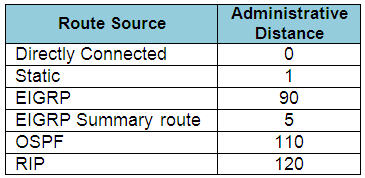- A router has learned three possible routes that could be used to reach a destination network. One route is from EIGRP and has a composite metric of 20514560. Another route is from OSPF with a metric of 782. The last is from RIPv2 and has a metric of 4. Which route or routes will the router install in the routing table?
- A. the RIPv2 route
- B. all three routes
- C. the OSPF and RIPv2 routes
- D. the OSPF route
- E. the EIGRP route*
Show (Hide) Explanation/ReferenceWhen one route is advertised by more than one routing protocol, the router will choose to use the routing protocol which has lowest Administrative Distance. The Administrative Distances of popular routing protocols are listed below:
- Which command can you enter to route all traffic that is destined for 192.168.0.0/20 to a specific interface?
- A. router(config)#ip route 192.168.0.0 255.255.240.0 GigabitEthernet0/1*
- B. router(config)#ip route 0.0.0.0 255.255.255.0 GigabitEthernet0/1
- C. router(config)#ip route 0.0.0.0 0.0.0.0 GigabitEthernet0/1
- D. router(config)#ip route 192.168.0.0 255.255.255.0 GigabitEthernet0/1
Show (Hide) Explanation/ReferenceThe simple syntax of static route:ip route destination-network-address subnet-mask {next-hop-IP-address | exit-interface}
+ destination-network-address: destination network address of the remote network
+ subnet mask: subnet mask of the destination network
+ next-hop-IP-address: the IP address of the receiving interface on the next-hop router
+ exit-interface: the local interface of this router where the packets will go outIn the statement “ip route 192.168.0.0 255.255.240.0 GigabitEthernet0/1″:
+ 192.168.0.0 255.255.240.0: the destination network
+ GigabitEthernet0/1: the exit-interface - Which command can you enter to set the default route for all traffic to an interface?
- A. router(config)#ip route 0.0.0.0 0.0.0.0 GigabitEthernet0/1*
- B. router(config)#ip route 0.0.0.0 255.255.255.255 GigabitEthernet0/1
- C. router(config-router)#default-information originate
- D. router(config-router)#default-information originate always
- Which three statements about static routing are true? (Choose three)
- A. It uses consistent route determination.*
- B. It is best used for small-scale deployments.*
- C. Routing is disrupted when links fail.*
- D. It requires more resources than other routing methods.
- E. It is best used for large-scale deployments.
- F. Routers can use update messages to reroute when links fail.
Show (Hide) Explanation/ReferenceThe static routing specifies a fixed destination so it is “consistent”. It is best used for small-scaled places where there are a few routers only. When links fail, static route cannot automatically find an alternative path like dynamic routing so routing is disrupted. - If host Z needs to send data through router R1 to a storage server, which destination MAC address does host Z use to transmit packets?
- A. the host Z MAC address
- B. the MAC address of the interface on R1 that connects to the storage server
- C. the MAC address of the interface on R1 that connects to host Z*
- D. the MAC address of the storage server interface
Show (Hide) Explanation/ReferenceHost Z will use ARP to get the MAC address of the interface on R1 that connects to it and use this MAC as the destination MAC address. It use the IP address of the storage server as the destination IP address.For example in the topology below, host A will use the MAC address of E0 interface of the router as its destination MAC address to reach the Email Server.

- Which routing protocol has the smallest default administrative distance?
- A. IBGP
- B. OSPF
- C. IS-IS
- D. EIGRP*
- E. RIP
Show (Hide) Explanation/ReferenceThe Administrative Distance (AD) of popular routing protocols is shown below. You should learn them by heart:
Note: The AD of iBGP is 200
The smaller the AD is, the better it is. The router will choose the routing protocol with smallest AD.
In this case EIGRP with AD of 90 is the smallest one.
- Which statement about static routes is true?
- A. The source interface can be configured to make routing decisions.
- B. A subnet mask is entered for the next-hop address.
- C. The subnet mask is 255.255 255.0 by default
- D. The exit interface can be specified to indicate where the packets will be routed.*
- Which component of a routing table entry represents the subnet mask?
- A. routing protocol code
- B. prefix
- C. metric
- D. network mask*
- When a router makes a routing decision for a packet that is received from one network and destined to another, which portion of the packet does if replace?
- A. Layer 2 frame header and trailer*
- B. Layer 3 IP address
- C. Layer 5 session
- D. Layer 4 protocol
Show (Hide) Explanation/ReferenceThe Layer 2 information (source and destination MAC) would be changed when passing through each router. The Layer 3 information (source and destination IP addresses) remains unchanged. - Which statement about routing protocols is true?
- A. Link-state routing protocols choose a path by the number of hops to the destination.
- B. OSPF is a link-state routing protocol.*
- C. Distance-vector routing protocols use the Shortest Path First algorithm.
- D. IS-IS is a distance-vector routing protocol.
- Which dynamic routing protocol uses only the hop count to determine the best path to a destination?
- A. IGRP
- B. RIP*
- C. EIGRP
- D. OSPF
CCNA 200-125 Exam: IP Routing With Answers
Subscribe
0 Comments
